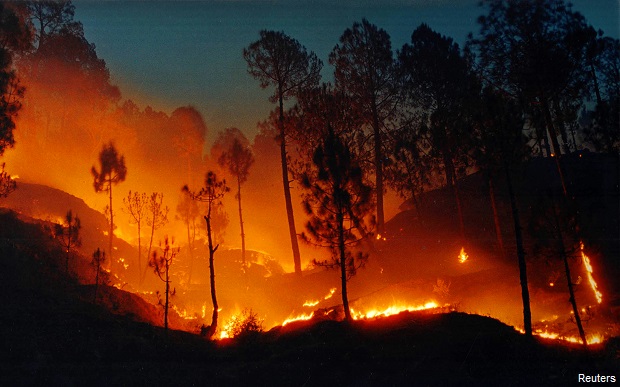Forest Fires Surge 30% In 2016
Forest fires over the first four months of 2016 surged 30%--20,667 fires were reported as on April 21, 2016 compared to 15,937 over 2015--according to data tabled in the Lok Sabha (lower house of Parliament) on April 26, 2016.
Fires swept more than 4,500 hectares of forest in the northern state of Himachal Pradesh since April 7, 2016. This is 40% more than the 3,185 hectares burnt in Uttarakhand since February 2, 2016.
Similarly, a forest fire broke out in Bathuni in the Rajouri district of Jammu and Kashmir on May 1, 2016.
While India faces a water shortage, it cost the Uttarakhand government Rs 85 per litre of water used to douse the fire using two Mi-17 helicopters.
Forests cover 701,673 square kilometres (sq km), or 21.34%, of India. Forested area increased by 9,646 sq km over four years between 2011 and 2015, according to the India State of Forest report.
As many as 117,369 forest fires were reported since 2011. Forest fires are a nationwide phenomenon but they vary in intensity and nature; the season for forest fires is from February to June.
While 54% recorded forested area is prone to fire, only about 6% Indian forests are prone to severe fire damages annually.
Source: Lok Sabha 1, 2; Figures for 2016 as on 21.04.2016.
The north-eastern state of Mizoram reported 2,468 forest fires—the most in 2015. Assam (1,656) was second, followed by Odisha (1,467), Meghalaya (1,373) and Manipur (1,286).
Source: Lok Sabha 1, 2; Figures for 2016 as on 21.04.2016; Ranking based on 2015 figures.
The top five states accounted for 52% of all forest fires across the country in 2015.
The eastern state of Chhattisgarh reported the most forest fires—2,422—in 2016 (as on April 21, 2016), followed by Odisha (2,349) and Madhya Pradesh (2,238).
More than 95% forest fires are caused by the negligence of human beings. The remaining 5% fires are caused by natural reasons like lightning and extreme rise in temperature.
"These (fires) are not new but this time due to the heat, the moisture level has reduced, which at times leads to situation like the ones in Uttarakhand and Himachal Pradesh," environment and forest minister Prakash Javadekar said on May 4, 2016.
Impact of forest fire
Forest fires in Uttarakhand could melt glaciers faster—black carbon from smog and ash is covering them, making them prone to melting—experts said.
Forest fires are major causes of degradation of environment as uncontrolled fires lead to burning of vegetation and surface organic matter, increasing the frequency of flooding and causing soil erosion.
Forest fires also lead to loss of valuable timber resources, disruption of wildlife patterns and habitat and climate change.
The economic loss of forest fire is estimated to be around Rs 90,000 per hectare per annum, according to the Forest Fire Disaster Management report.
Forest fires around the world
An average of more than one million hectares of forests are burnt annually due to fires in countries like Chad, Australia, United States of America, India and Canada.
Forest fires have been a seasonal phenomenon in Indonesia, caused due to the practice of slash-and-burn agriculture. More than 130,000 forest fires occurred last year, IndiaSpend reported earlier. It was also reported how Indonesian fires are affecting the global climate.
The Indonesian government estimates that 63% of its greenhouse gas emissions are the result of forest and peat-land fires.
(Mallapur is an analyst with IndiaSpend.)
We welcome feedback. Please write to respond@indiaspend.org. We reserve the right to edit responses for language and grammar.
__________________________________________________________________
Liked this story? Indiaspend.org is a non-profit, and we depend on readers like you to drive our public-interest journalism efforts. Donate Rs 500; Rs 1,000, Rs 2,000.



